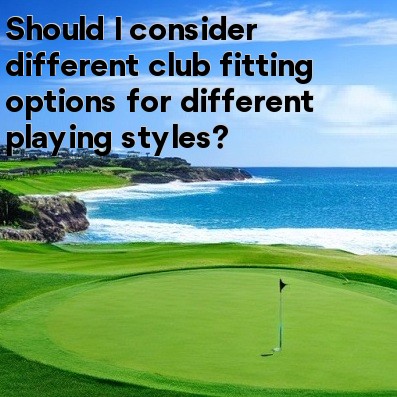
Should I consider different club fitting options for different playing styles?
Club fitting is an essential aspect of golf that often goes overlooked by amateur players. Many golfers fail to realize the importance of having properly fitted clubs for their individual playing styles. Whether you are a beginner or an experienced golfer, considering different club fitting options can greatly enhance your game on the course.
Every golfer has a unique playing style, swing speed, and body type. These factors directly impact how you interact with the golf clubs. Therefore, it is crucial to consider club fitting options to ensure that your clubs are perfectly tailored to your needs.
One of the main reasons to consider different club fitting options is to optimize your swing. A club that is too long or too short can negatively affect your swing plane, timing, and consistency. With the help of a professional club fitter, you can determine the right length and lie angle for your clubs, which will result in improved ball striking and accuracy.
Another aspect of club fitting to consider is the shaft flex. The shaft's flexibility determines the amount of bend during the swing. Players with high swing speeds typically require stiff or extra-stiff shafts, while those with slower swing speeds benefit from more flexible shafts. By having the correct shaft flex, you can maximize your distance and achieve better control over your shots.
In addition to length and shaft flex, club fitting also takes into account other important factors such as grip size and clubhead design. The right grip size ensures a comfortable and secure hold on the club, preventing excessive wrist movement and improving your ability to square the clubface at impact. Clubhead design, including its size and weight distribution, can also impact your ability to achieve the desired ball flight and forgiveness.
Different playing styles require different club fitting options. For example, if you tend to slice the ball, a club fitter may suggest adjusting the clubface angle or using clubs with a draw bias. Alternatively, if you struggle with consistent ball striking, club fitting can help identify areas for improvement and recommend changes in your equipment to compensate.
- Get properly fitted for your clubs by consulting with a professional club fitter.
- Consider your swing speed and playing style when determining the appropriate shaft flex.
- Take into account factors such as grip size and clubhead design to optimize your performance.
- Be open to making adjustments to your equipment based on the recommendations of a club fitter.
In conclusion, club fitting is an important element of golf that should not be overlooked. Different playing styles require different club fitting options, and getting properly fitted clubs can significantly enhance your performance on the course. By considering factors such as length, shaft flex, grip size, and clubhead design, you can ensure that your clubs are perfectly suited to your individual needs and maximize your potential in the game of golf.





